Introduction
In the pursuit of fitness and overall well-being, understanding the role of oblique muscles is paramount. These vital muscles, nestled on the sides of the abdomen, are not just key players in core stabilization; they are essential for effective movement and injury prevention.
Recent research highlights their significance, particularly among athletes, revealing that a strong and balanced set of obliques can dramatically enhance performance and reduce the risk of injuries. By integrating targeted exercises into workout routines, individuals can cultivate a robust core that supports both athletic endeavors and daily activities.
This article delves into the importance of oblique muscles, offering practical exercises and expert tips to maximize results, ensuring a comprehensive approach to fitness that champions strength, stability, and health.
Understanding Oblique Muscles and Their Importance in Fitness
Oblique structures, located on the sides of your abdomen, are essential in stabilizing your core, enabling effective rotational movements, and maintaining proper posture. Recent studies emphasize their significance, showing that athletes, especially hurdlers, exhibit notable variations in thickness and strength ratios between sides. For instance, research indicates a significant thickness change in the left external muscle in hurdles from rest to contraction, emphasizing the need for balanced training.
Hides et al. noted that another study tested in the supine position and with contraction via abdominal hollowing observed a significant thickness increase in the internal oblique (IO), highlighting how targeted exercises can enhance stability. Strengthening these areas not only boosts athletic performance but also significantly reduces the risk of injuries, improves balance, and supports the functional movements essential in daily life.
The case study titled 'Statistical Analysis of Muscle Thickness and Strength' compared hurdlers and sprinters, focusing on asymmetry between sides during their respective athletic events, which provides further insight into the differences in muscle characteristics and the need for balanced training. By incorporating an obliques workout dumbbell into your fitness routine, you can create a foundation for a stronger midsection, leading to better overall health and improved performance. This commitment to core stability and lateral training is not merely a trend; it is a foundational aspect of a well-rounded fitness strategy that champions both wellness and peak performance.
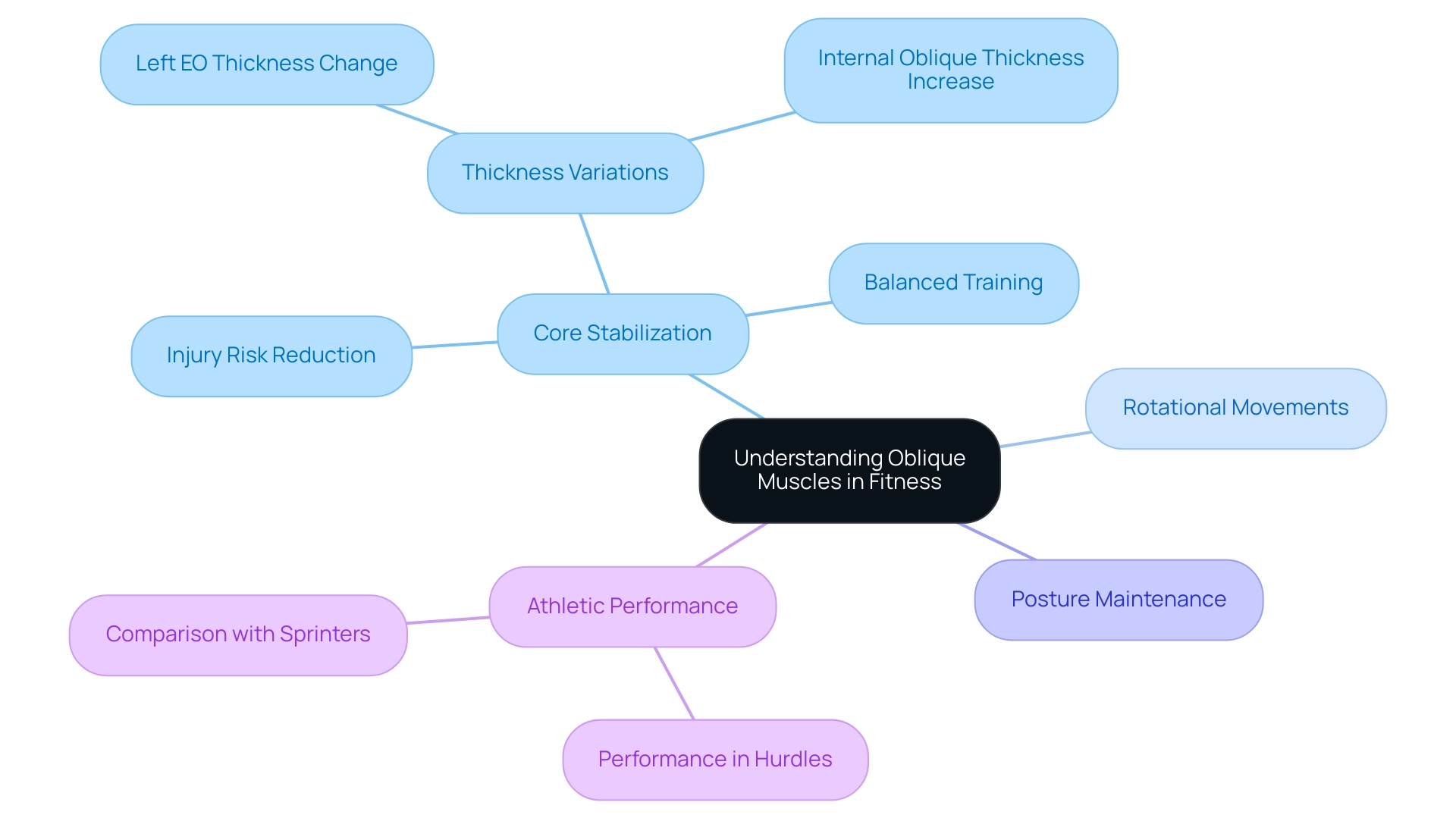
Essential Dumbbell Exercises for Effective Oblique Workouts
To effectively focus on your side muscles, consider incorporating these essential dumbbell routines into your regimen:
- Dumbbell Side Bend: Stand tall with your feet shoulder-width apart, clutching a dumbbell in one hand. Slowly bend to the side, bringing the dumbbell down towards your knee, then return to the upright position. This exercise not only strengthens your side muscles but also enhances flexibility. Repeat on both sides for balanced development.
- Russian Twist: Position yourself on the floor with your knees bent, holding a dumbbell with both hands. Lean back slightly and elevate your feet off the ground, activating your abdominal muscles. Rotate your torso to one side, then the other, while maintaining control. Aim for 3 sets of 15 to 20 reps to maximize results and build endurance.
- Dumbbell Woodchopper: Stand with your feet shoulder-width apart, gripping a dumbbell with both hands. Begin with the dumbbell above one shoulder and chop it diagonally across your body towards the opposite hip. This dynamic movement engages your side muscles effectively, making it a staple for an obliques workout.
- Dumbbell Plank with Rotation: Assume a plank position with a dumbbell in each hand. Rotate your torso, lifting one dumbbell towards the ceiling while keeping your hips stable. Alternate sides, ensuring your center remains engaged throughout the movement. This obliques workout dumbbell not only strengthens your obliques but also improves the overall stability of the trunk.
- Dumbbell Crossover Plank: Get into a plank position while holding a dumbbell in each hand. Alternate raising each dumbbell towards your opposite shoulder while keeping a stable torso. To effectively engage your obliques, perform 3-4 sets of 8-10 repetitions using an obliques workout dumbbell with 60-90 seconds of rest between sets.
Including these exercises three to five times a week, as advised by fitness professionals such as McManus, can result in noticeable strength and enhanced stability. Remember, proper execution is crucial to prevent injury and ensure maximum effectiveness. As Reyna Franco notes, integrating resistance training can greatly enhance overall strength, including for the obliques.
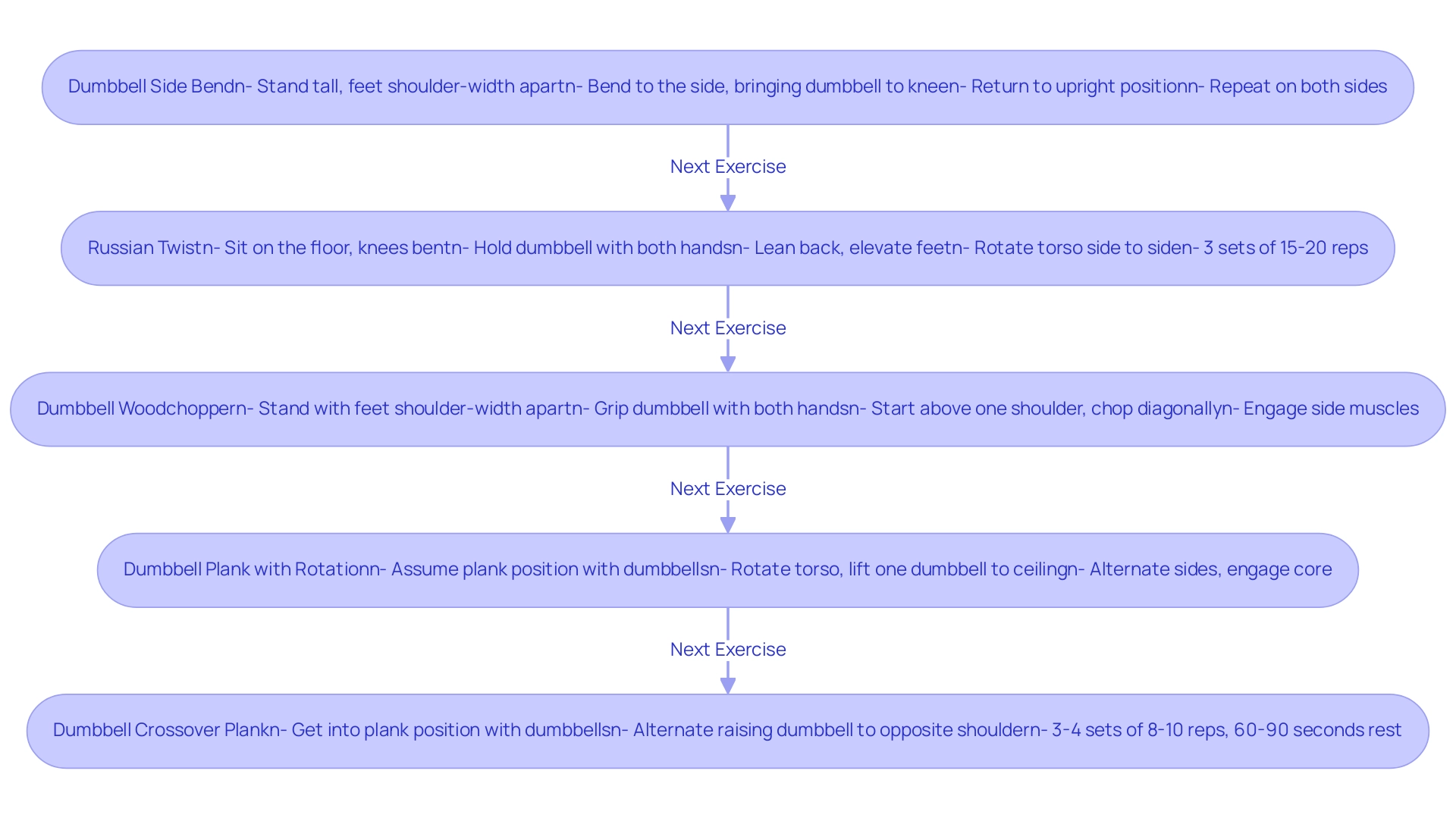
Step-by-Step Guide to Performing Dumbbell Oblique Exercises
Here’s a motivational step-by-step guide for mastering the Dumbbell Side Bend:
- Starting Position: Stand tall with your feet positioned shoulder-width apart, gripping a dumbbell in your right hand, allowing it to hang comfortably at your side.
- Engage Your Center: Activate your central muscles to stabilize your body, laying the foundation for effective movement. Study by McGill & Marshall (2012) highlights the significance of fundamental involvement, especially in male participants, for optimal physical performance.
- Bend to the Side: Gently bend your torso to the right, lowering the dumbbell toward your knee while keeping your legs straight and your back aligned. This movement is essential for improving central stability, as emphasized by Fletcher & Bagley, who observed that heightened central stability is connected to physical activity effectiveness and general well-being.
- Return to Start: Engage your obliques powerfully as you return to the starting position, feeling the contraction in your side muscles as you rise. Including activities such as the obliques workout dumbbell, specifically the Dumbbell Side Bend, can greatly enhance stability of the midsection, as shown by research on stability training.
- Repeat: Complete 10-15 repetitions on one side before switching to the left side, ensuring each movement is controlled and precise.
For a comprehensive workout, follow similar steps for activities like the Russian Twist, Dumbbell Woodchopper, and Dumbbell Plank with Rotation. Maintain proper form throughout each movement to maximize effectiveness and minimize the risk of injury. Remember, as the case study titled "Implications for Core Stability Training" suggests, incorporating specific exercises can enhance core stability and assist in recovery from core-related injuries, making these exercises essential for promoting employee wellness.
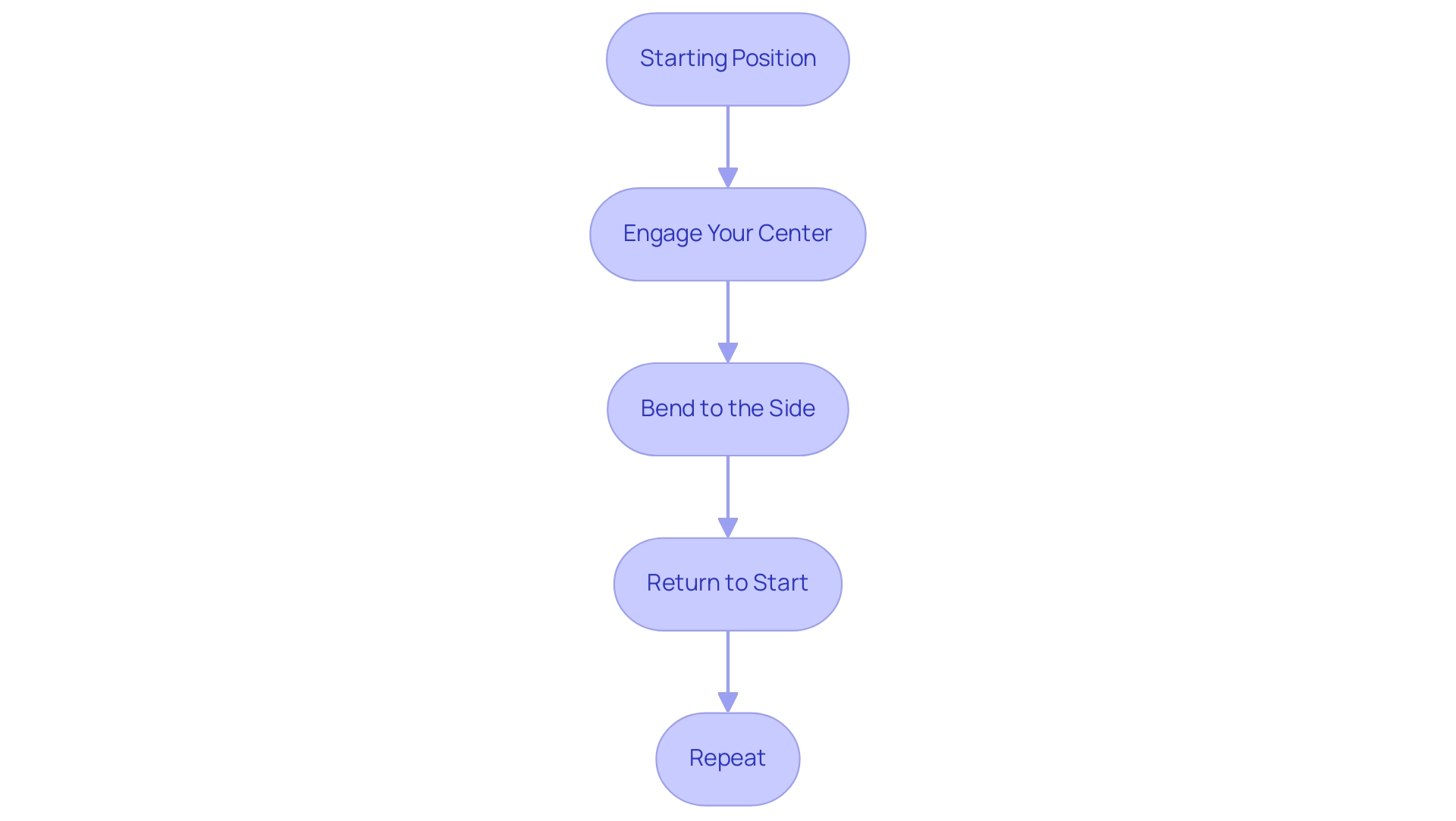
Tips for Maximizing Your Dumbbell Oblique Workout Results
To truly maximize the effectiveness of your obliques workout dumbbell, embrace the following strategies:
-
Prioritize Form: The foundation of any successful workout lies in proper technique. By concentrating on form instead of the weight lifted, you enhance engagement and minimize the risk of injury—key components for sustainable fitness progress.
As noted by fitness experts, referencing statistics can bolster your approach; you’re (of course!) welcome to reference the statistics in this report, but please credit us with a link to this site if you do so.
-
Gradually Increase Intensity: As your strength improves, it's essential to challenge your body.
Incrementally increase the weight of your dumbbells in your obliques workout dumbbell or the repetitions performed. According to Oliver et al. (2015), utilizing progressive overload—such as increasing weights or sets—can lead to significant strength gains and tissue development.
-
Incorporate Variety: Keep your workouts engaging by integrating a diverse range of side exercises. This not only staves off boredom but also allows you to target your muscles from different angles, promoting balanced development.
-
Consistency is Key: Commit to performing your targeted workouts at least 2-3 times a week.
Regular engagement is vital for seeing significant improvements and achieving your fitness goals. A case study on strength training for weight loss in older adults demonstrated that consistent strength training combined with diet led to a 19% loss in body fat mass, underscoring the effectiveness of a dedicated routine.
-
Combine with a Balanced Routine: For comprehensive fitness results, complement your side exercises with full-body strength workouts and cardio.
This holistic approach ensures you build strength and endurance effectively, enhancing overall fitness performance.
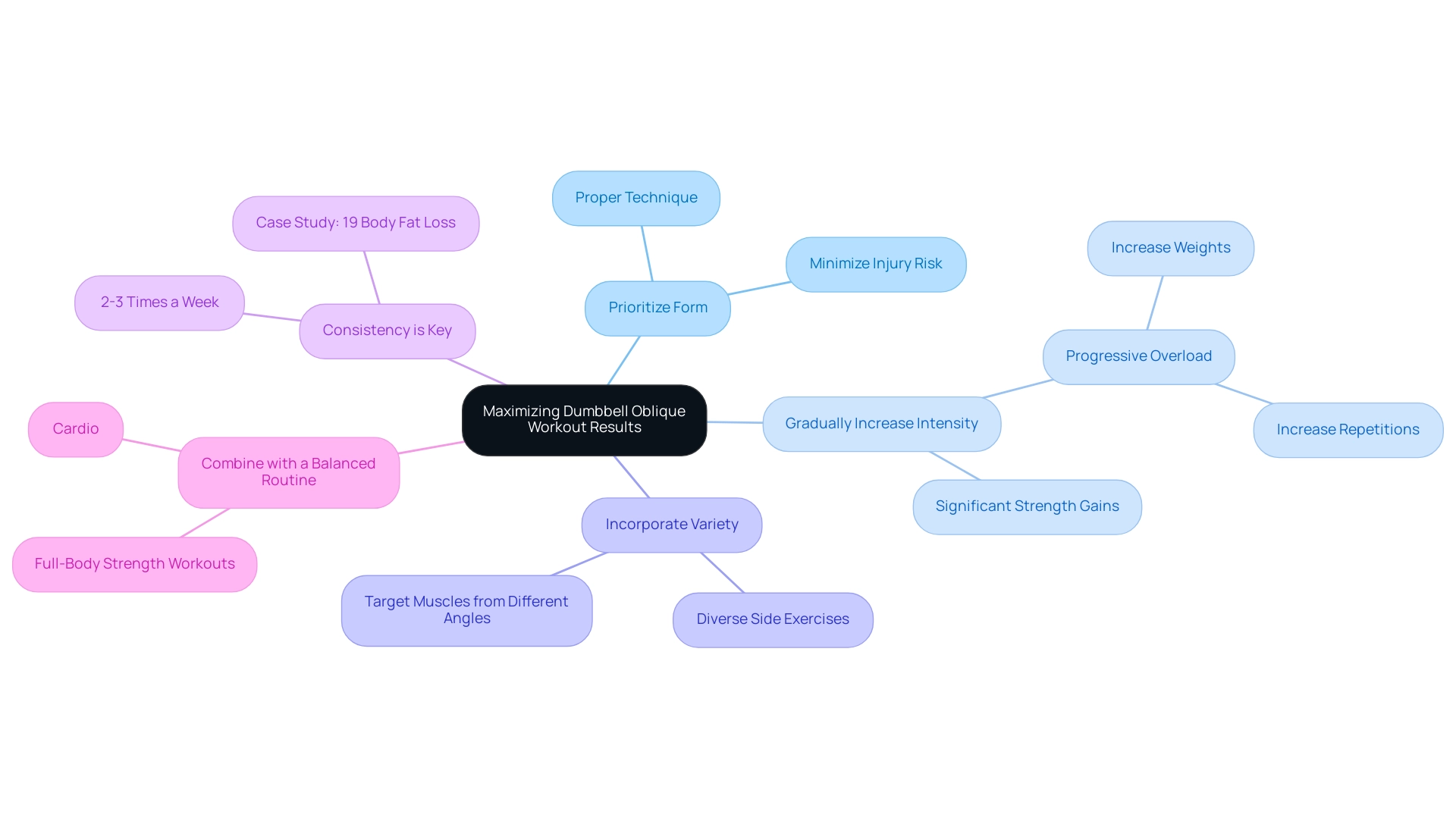
Common Mistakes to Avoid in Dumbbell Oblique Workouts
To ensure a safe and effective obliques workout dumbbell, it’s crucial to avoid the following common mistakes:
- Disregarding Central Engagement: Failing to engage your center can result in improper form and reduced workout effectiveness. Always remember to tighten your core during workouts to support stability and strength.
- Using Excessive Weight: Lifting weights that are too heavy not only compromises your form but also elevates the risk of injury. Start with lighter weights, focusing on mastering your form and technique before progressing. Aim to lift weights at least three times per week to build strength effectively.
- Rushing Through Repetitions: Speeding through your activities can significantly reduce their effectiveness. Take your time—ensure each movement is controlled and deliberate to maximize the benefits.
- Neglecting Proper Breathing: Forgetting to breathe correctly during workouts can hinder your performance. Exhale during exertion and inhale during the return phase of each exercise to maintain optimal oxygen flow.
- Skipping Warm-Up and Cool-Down: Always include a proper warm-up before starting your workout and a cool-down afterward. This practice not only prevents injuries but also promotes recovery, allowing your body to adapt to the training.
As noted by fitness expert Carmelo Bosco,
Trainers sometimes forget that the tissue is driven by an impulse that started from the brain and that has activated a series of nervous systems to get to the tissue synapse and activate contraction.
Engaging the core and using proper form is essential to harnessing this connection effectively. Additionally, understanding that capillaries encircle each fiber for metabolite exchange emphasizes the physiological advantages of maintaining proper form and technique.
A case study on resistance training protocols demonstrated that both training to failure and stopping short of failure can effectively promote muscle adaptations, reinforcing the importance of avoiding mistakes in angled workouts. By avoiding these pitfalls, you can enhance your obliques workout dumbbell training, improve performance, and reduce injury rates, creating a safer and more effective exercise routine.
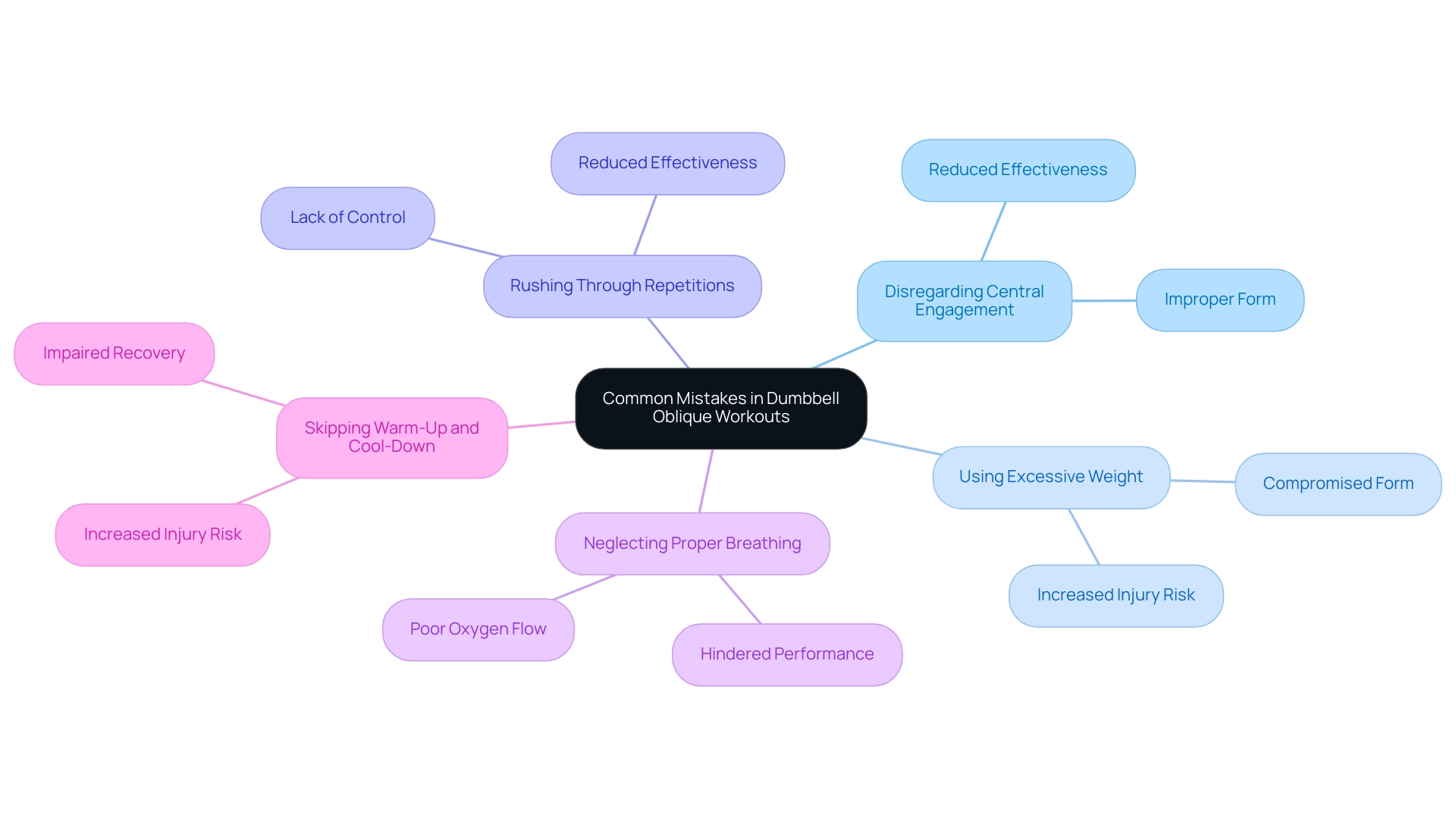
Conclusion
Integrating oblique muscle training into fitness routines is not just beneficial; it is essential for achieving optimal performance and preventing injuries. The significance of these muscles, located on the sides of the abdomen, extends beyond aesthetics; they play a crucial role in core stability, effective movement, and overall functional fitness. By prioritizing balanced training and employing targeted exercises such as:
- Dumbbell side bends
- Russian twists
- Woodchoppers
individuals can develop a stronger core that enhances athletic performance and daily activities alike.
To maximize results, it is vital to focus on proper form and gradually increase intensity. Consistency is key; committing to regular oblique workouts can lead to significant improvements in strength and stability. Engaging in a variety of exercises not only keeps workouts interesting but also ensures comprehensive muscle development. By avoiding common mistakes, such as neglecting core engagement or rushing through repetitions, individuals can enhance the effectiveness of their training and foster a safer workout environment.
Ultimately, the commitment to strengthening oblique muscles is a foundational aspect of a well-rounded fitness strategy. Embracing these principles leads to improved health, enhanced performance, and a proactive approach to well-being. It is time to take action, prioritize core stability, and reap the myriad benefits that come from a dedicated focus on oblique training.




